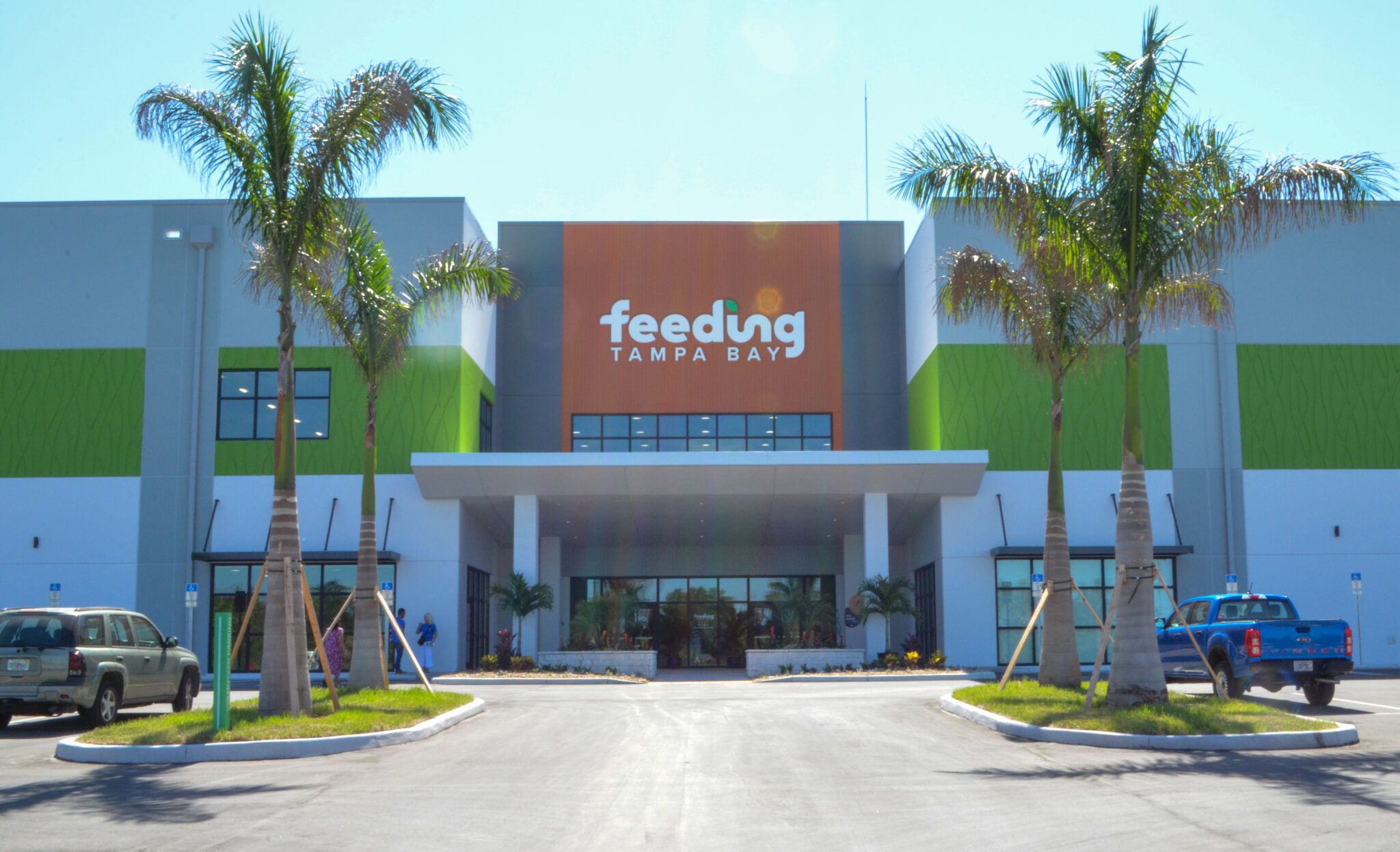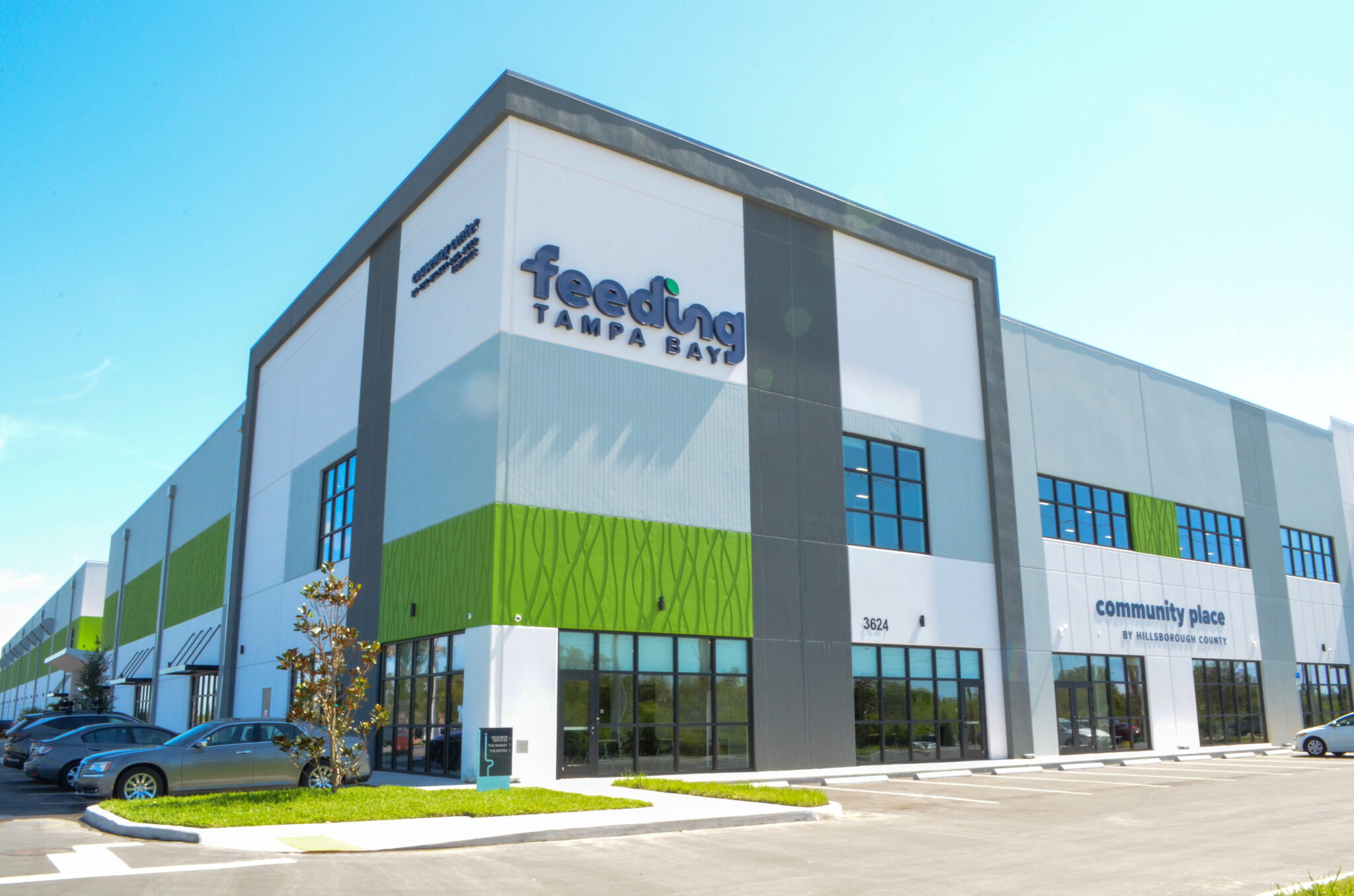Feeding Tampa Bay's New Causeway Center Now Open
BDG Architects led the design of the groundbreaking Feeding Tampa Bay project, now known as the Causeway Center. This $60 million investment symbolizes a commitment to addressing food insecurity and community well-being in Tampa Bay. The center, spanning 215,000 SF, is the region's first of its kind, providing vital services to 10 counties in West and Central Florida. Equipped with 1,000 SF of cold storage, an 11,000 SF kitchen, and facilities for a food bank and clinic, it stands as a beacon of support. Constructed from 84 concrete tilt-up panels, the Causeway Center is now open.
Tampa Bay Times
By Christopher O'Donnell - Times staff
TAMPA — Despite the hot, sticky Florida day, it was a chilly 35 degrees inside a refrigerated area of Feeding Tampa Bay’s new $60 million warehouse on a recent Monday.
That’s nothing compared to the arctic-like air inside the warehouse’s freezer, where underfloor pipes circulate coolant to temperatures of -5 degrees even if it’s 100 degrees outside.
Over the next few weeks, the warehouse will begin taking delivery of thousands of pounds of tomatoes, milk, lettuce, melons and other perishable food donated by grocery stores and other businesses. The extra storage means the nonprofit will no longer have to turn away as much as 30% of donated perishable food.
Known as the Causeway Center, the group’s new 215,000-square-foot warehouse and headquarters formally opened Thursday. It will increase the food bank’s capacity from 85 million to 150 million meals per year, officials say.

But the nonprofit has its sights set higher than just feeding the area’s needy. Roughly one-third of the building located just southeast of Port Tampa Bay is being offered free to partner nonprofits to provide help with housing, health care and job training. There will be services for veterans and seniors, a free grocery store, and a café that operates on a pay-what-you-can basis.
A new 11,000-square-foot kitchen will pump out meals, including those served at Trinity Cafe locations that cater to low-income families and homeless people.
The group describes the new center as the largest social services project in Tampa Bay history. It’s the only approach that will change the long-term plight of the estimated 1 million food insecure residents in the Tampa Bay region, said CEO Thomas Mantz.
“For a long time, there was this ongoing belief that somehow we’re going to food bank our way out of this problem. We’re not,” he said. “What we’re really trying to do is build a much more thoughtful infrastructure that addresses long-term economic issues and communities.”
The center is a major investment by the nonprofit, which on its most recent tax return in 2022 reported revenues of $185 million, roughly $3 million more than it spent that year. Companies that donated toward the center include long-time partners BayCare Health System and Florida Blue. Hillsborough County contributed $5 million from its allocation of federal American Rescue Plan Act dollars targeting COVID-19 relief.
Mantz said the group went into the project knowing it could afford to take on a mortgage if necessary, but he is hopeful the project won’t mean long-term debt. Vacating its 80,000-square-foot warehouse on Adamo Drive will save the nonprofit $700,000 per year in rent.
Planning and fundraising for the project have been in the works for about five years. Mantz and some of the group’s governing board toured recently constructed food banks as far away as Texas and Arizona looking for ideas about design and operation.

However, the CEO admits the expansion of the group’s mission is uncharted territory. Measuring its success may come not from counting the number of meals served, but rather the economic impact of the center. That would include metrics such as the number of people joining the workforce as a result of a 300% expansion of its working training programs for culinary arts, warehouse logistics, commercial driver’s license and a barista program offered in partnership with Starbucks.
“This is an experiment in the unknown,” Mantz said. “We didn’t find another food bank in the United States that was doing this.”
The south side of the building, dubbed “Community Place,” will be the welcoming face of the center for those seeking social services — where as many as 25 different nonprofits may be taking advantage of free office space.

In addition to a grocery store and café, there will be computer stations for visitors to apply for jobs and benefits. Free classes will be offered on topics like taxes and financial literacy. It also includes Causeway Hall, a venue for public events with space for 485 people.
Surveys conducted by the nonprofit found that almost a third of the people they serve do not have access to medical care. Community Place will have two medical examination rooms staffed by BayCare. The health provider already partners with Feeding Tampa Bay on several initiatives, including community food clinics offering free healthy food and health screenings.
“Our expanded area includes two exam rooms that will allow for us to consider providing flu shots, school physicals and other primary preventive services,” said spokesperson Lisa Razler in an email.
One of the partnerships is with Metropolitan Ministries, which will save roughly $200,000 a year by storing its donated food at the new warehouse, according to its CEO Tim Marks. In exchange, it will assign case managers and people trained in helping others find social services at the center.
There are still some wrinkles to iron out. Many of those the group serves do not have their own transportation, but the closest Hillsborough Area Regional Transit bus stop is 2.2 miles from the center at the intersection of 50th Street and Palm River Road. The group is lobbying local agencies including HART to bring bus service closer.
The nonprofit’s governing board fully backs the expansion of its mission, said Todd Wickner, a retired food service executive who has served on the board for 12 years. Everyone who needs a meal has other needs, too, he said.
“When you walk through the doors, you start understanding how the spaces will work and how well they will mesh together,” he said. “I got goosebumps from seeing that our vision is coming to fruition.”

• • •
Feeding Tampa Bay’s new Causeway Center by the numbers:
- 215,000 - Square footage of The Causeway Center
- 28,000 - square footage of refrigerated warehouse area, including freezer and special dry area for beans and rice
- 4,500 - number of 5-tier food racks
- 550 - parking spots, including 50 for trucks
- 35,000 - square footage of community space
- 150 million - annual meal capacity
- 1,000 - number of trucks worth of fill dirt used to elevate center 13 feet above ground level
- 8 feet - height above 100-year floodplain
- $60 million cost of the 5-year project
- 1 million - number of food insecure in the Tampa Bay region
Read more in the Tampa Bay Times.
